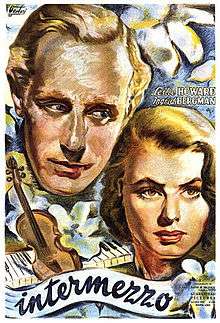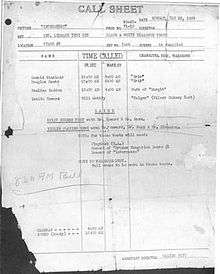Intermezzo (1939 film)
| Intermezzo | |
|---|---|
 1945 Argentine film poster | |
| Directed by | Gregory Ratoff |
| Produced by | David O. Selznick |
| Screenplay by | George O'Neil |
| Story by |
Gösta Stevens Gustaf Molander |
| Starring |
Leslie Howard Ingrid Bergman Edna Best John Halliday Cecil Kellaway |
| Music by |
Max Steiner Heinz Provost |
| Cinematography |
Gregg Toland Harry Stradling Sr. |
| Edited by | Francis D. Lyon |
Production company | |
| Distributed by | United Artists |
Release date |
|
Running time | 70 minutes |
| Country | United States |
| Language | English |
Intermezzo (also called Intermezzo: A Love Story) (1939) is a romantic film made in the USA by Selznick International Pictures and nominated for two Academy Awards. It was directed by Gregory Ratoff and produced by David O. Selznick. It is a remake of the Swedish film Intermezzo (1936) and features multiple orchestrations of the Heinz Provost's piece of the same name, which won a contest associated with the original film's production.[1] The screenplay by George O'Neil was based on the screenplay of the original film by Gösta Stevens and Gustaf Molander. The scoring by Lou Forbes was nominated for an Academy Award,[2] and music credit was given to Robert Russell Bennett, Max Steiner, Heinz Provost, and Christian Sinding. The cinematography by Gregg Toland who replaced Harry Stradling was also nominated for an Academy Award.[2]
It stars Leslie Howard as a (married) virtuoso violinist who falls in love with his accompanist, played by Ingrid Bergman in her Hollywood debut.
Plot
Holger Brandt, a famous virtuoso violinist, meets Anita Hoffman, his daughter's piano instructor, during a trip home. Impressed by Anita's talent, he invites her to accompany him on his next tour. They begin touring together and a passionate relationship ensues. Holger's wife Margit asks him for a divorce.
Knowing how much Holger misses his daughter Ann Marie and son Eric, and torn with guilt for breaking up his family, Anita decides to pursue her own career and leaves Holger. Holger returns home to see his children again. He first travels to Ann Marie's school, but as she runs across the street to greet him she is hit by a car in front of his eyes. He takes the injured Ann Marie back home, and confronts his angry son in an attempt to explain his infidelity.
To Holger's relief, the doctor informs him that Ann Marie will survive and eventually recover from her injuries. Margit then forgives Holger and welcomes him back into his family.
Cast
- Leslie Howard as Holger Brandt
- Ingrid Bergman as Anita Hoffman
- Edna Best as Margit Brandt
- John Halliday as Thomas Stenborg
- Cecil Kellaway as Charles Moler, The Impresario
- Enid Bennett as Greta Stenborg
- Ann E. Todd as Ann Marie Brandt (as Ann Todd)
- Douglas Scott as Eric Brandt
- Eleanor Wesselhoeft as Emma, The Maid
- Marie Flynn as Marianne
Production

The musical duets, with Howard and Bergman, were dubbed for the soundtrack by professional musicians; however, the actors' hands show the actual music being played:[3] Ingrid Bergman plays the full piano parts (for Edvard Grieg's Concerto in A minor and Christian Sinding's "Rustle of Spring"), so her hand positions are correct for the music soundtrack. Leslie Howard, however, could not play the violin, so a professional violinist — who also bore a striking resemblance to Leslie Howard — was brought in to teach him proper violin posture and bowing technique. During filming, this same musician, Al Sack, rested on his knees, out of view of the camera, and did the fingering on all of the close-ups. In the film, viewers see Sack's left hand and Mr. Howard's bowing arm and profile. Sack also doubled for Howard during the long shots in front of the orchestra.[3]
Vienna comment
In the crucial scene where the film's two main protagonists stand looking into the river and realize that they have fallen in love with each other, Holger Brandt (Leslie Howard) makes a casual remark on "the time when Vienna was a happy city". This is taken by many to be a reference to the 1938 de facto annexation of Austria by Nazi Germany. However, Brandt's comment also features in the original, 1936, Swedish film, which predated the Anschluss. Others more accurately understand it to mean the period of one-party rule forced on Austria by the Patriotic Front, Austria's own fascist party, which took power in 1933. The remark may also refer to Vienna's previous imperial glory prior to the First World War, which led to the collapse of the Austro-Hungarian Empire.
Accolades
The film is recognized by American Film Institute in these lists:
- 2002: AFI's 100 Years...100 Passions – Nominated[4]
Radio adaptations
Ingrid Bergman performed in a radio adaptation of Intermezzo on Lux Radio Theater on January 29, 1940, which also starred Herbert Marshall. She was also in another adaptation on the same show on June 4, 1945 with Joseph Cotten. On October 5, 1946, Marshall starred in an adaptation of Intermezzo on Hollywood Star Time.[5]
Remake
The film was remade as Honeysuckle Rose in 1980.[6]
Notes
- ↑ IMDB, Heinz Provost
- 1 2 12th Annual Academy Award Nominations
- 1 2 Ingrid: Ingrid Bergman, a Personal Biography (book), Charlotte Chandler, New York: Simon & Schuster, 2007, 334 pages: page 69 quotes Bergman about filming hands and playing piano with her family.
- ↑ "AFI's 100 Years...100 Passions Nominees" (PDF). Retrieved 2016-08-19.
- ↑ "H. Marshall Is "Star Time" Host". Harrisburg Telegraph. October 5, 1946. p. 17. Retrieved October 2, 2015 – via Newspapers.com.

- ↑ The Filmgoer's Companion — by Leslie Halliwell
External links
- Intermezzo: A Love Story at AllMovie
- Intermezzo: A Love Story at Rotten Tomatoes
- Intermezzo: A Love Story at the TCM Movie Database
- Intermezzo: A Love Story on IMDb
- Intermezzo on Lux Radio Theater: June 4, 1945